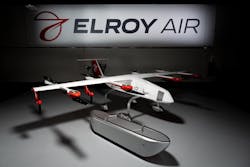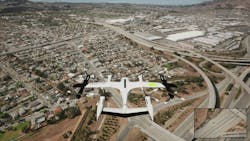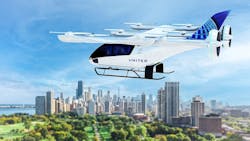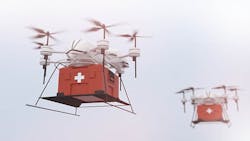The city soundscape soon may be abuzz with a variety of electric vertical takeoff and landing (eVTOL) aircraft ferrying passengers and cargo across dense urban centers high above the crowded streets below.
As with any nascent technology, there are a glut of designs as the market shakes out which provide the safety, resiliency, comfort, and demand operators need to transform the commuting public into frequent flyers taking short jaunts across cities or metro areas.
The National Aeronautical and Space Administration (NASA) estimates that 130 million passenger trips may be taken by the year 2029. Some market prognosticators estimate the UAM market to grow from $2.2 billion in 2021 to $31 billion in 2031.
In the intervening years, the urban air mobility (UAM) sector of eVTOL flying taxis will need to see rapid adoption of regulations, best practices, and infrastructureinvestment to enable safe air travel in cities dominated by tall buildings, huge radio frequency (RF) transmission traffic, and soon, other aircraft.
While many focus on passengers flying over traffic jams in city centers, the UAM sector is more broad than that. In addition to the promise of a flying taxi, autonomous eVTOL, hybrid, and traditionally fueled aircraft operators say they intend to find customers for air shuttles, personal air vehicles, air cargo, air ambulances/emergency vehicles, last-mile delivery, and similar military applications. These aircraft may be piloted remotely or with a pilot on-board or be fully autonomous in intracity and intercity routes.
As of 2023, the eVTOL aircraft directory of the Vertical Flight Society in Fairfax, Va., has more than 300 designs registered that feature lift and thrust layouts, including what look like a much larger version of a consumer quadcopter drone; distributed multi-copters; designs that use hybrid concepts where fixed or tilted wings drive forward flight while other fans or propellers are used for liftoff, hovering, and landing; and speedy jet designs. Each, of course, have their own pros and cons.
In addition to UAM's goals of moving people and goods around densely populated environments, the same technology is also anticipated for outside of city centers for civilian and military use and is referred to as advanced air mobility (AAM).
Building for the future
The U.S. Federal Aviation Administration (FAA) in Washington notes that UAM aircraft initially will use a flight ecosystem already in place for traditional helicopters that consists of routes, helipads, and air traffic control (ATC) services. In March 2023, the FAA started to establish standards for UAM-focused vertiports including signage and specifications for concrete.
"The draft [engineering brief] is based on research conducted by the FAA on the performance characteristics of various aircraft designs, currently under development, that will utilize vertiport facilities," the agency wrote in an announcement last spring. "The draft guidance contains a discussion of a composite aircraft (or reference aircraft), and the recommended safety standards contained in the draft guidance are only applicable to vertiports used by this composite aircraft or by any aircraft within the range of performance characteristics as this composite aircraft. The draft safety standards are not applicable for vertiport facilities that will be utilized by other types of aircraft outside the performance characteristics of this composite aircraft."
While agencies are establishing standards, engineers are figuring out how to distribute small-takeoff and -landing zones around cities that allow for safe maintenance, as well as for passenger and cargo loading and unloading.
While the Earth-bound nuts-and-bolts are established, companies from aviation giants like Airbus in Toulouse, France, and Boeing in Arlington, Va., to automotive and industrial players like Hyundai in Seoul and Toyota in Tokyo, as well as tech-forward start-ups attempt to establish a footprint in the UAM sector.
Major American passenger air carriers like United Airlines in Chicago and others worldwide like Brazil's Azul have made significant investments in UAM. In September, United announced plans to buy 200 four-seat eVTOL aircraft from Brazilian manufacturer Embraer's subsidiary Eve Air Mobility with an option for 200 more.
Eve's design uses conventional fixed wings, rotors, and pushers, giving it a lift-plus-cruise design and has a range of 60 miles and claims to reduce noise levels by90 percent compared to current conventional aircraft. Eve also is creating air traffic management to enable the UAM industry to scale safely. This software is to perform at the same safety level as Embraer's existing air traffic management software.
Simulations for safety
Last month, Hyundai Motor Group's Supernal announced that it was collaborating with Redmond, Washington's Microsoft to integrate the software giant's Azure cloud platform to run simulations to test and train autonomous aircraft transportation.
Microsoft says it will provide Supernal early access to Project AirSim, an artificial intelligence (AI)-first simulation platform, to build, test, train and validate safe autonomous aircraft transportation through simulation. Project AirSim uses Azure to generate significant amounts of environment and sensory data to train machine learning models that simulate all phases of flight and variable weather patterns. Project AirSim provides libraries of pretrained AI models and planet-scale 3D environments representing urban and rural landscapes, as well as a partner ecosystem offering synthetic data generation.
"Air transport is a key pillar in the democratization of mobility, connecting more people, goods and places through safe flight experiences," says Ulrich Homann, corporate vice president Cloud + AI at Microsoft. "With the Microsoft Cloud, Supernal can unlock the computing power it takes to build, validate, and deploy electric air vehicles at scale, spurring the commercialization of advanced air mobility solutions."
Real-time software expert Wind River Systems in Alameda, Calif., also offers a cloud-based solution for UAM/AAM and other mission-critical intelligent systems with Wind River Studio.
Wind River Studio is a cloud-native platform for the development, deployment, operations, and servicing of mission-critical intelligent systems, and offers solutions to meet both DO-178C and DO-356A, says Alex Wilson, director of aerospace and defense solutions at real-time software expert Wind River Systems in Alameda, Calif.
"Wind River Studio provides the fundamental building block of future intelligent avionics, based on a modern development environment where the process requirements of safety and security are built into the automated software development process," Wilson says. "Wind River Studio safety-certified platforms support popular architectures in aviation such as Arm, Intel, and PowerPC. Wind River Studio includes automated validation and verification using digital twins. This allows software developers to not only meet the regulatory requirements, but also to provide innovative capabilities across the fleet using the cloud to scale their operations."
Safety first
Before United passengers can catch a flight from a Long Island vertiport to LaGuardia airport, designers and engineers need to earn the confidence not only of future flyers, but also of regulators. With many aircraft aiming for totally or partially autonomous flight, experts need to demonstrate flawless systems that do both.Wind River's Wilson notes that the highest challenge is ensuring these aircraft operate safely and securely in a challenging environment.
"A dense urban environment means that you cannot have these aircraft causing fatalities due to either airworthiness reasons or to cyber-attacks," Wilson says. "Regulations must play a part in this challenge. This covers many aspects of the aircraft life cycle, from development to deployment and operations. This is in some ways no different to commercial aircraft, with regulations on how you obtain airworthiness, what conditions your aircraft is built to operate in, and how you maintain that airworthiness through the life cycle. Added to this are regulations on how you are allowed to operate through the airspace, including what communications and sensors you need to comply."
Wilson says that as manufacturers achieve airworthiness from regulators like the FAA and the European Aviation Safety Agency (EASA), designers must analyze potential failure modes and provide the necessary migrations to make sure there aren't any deadly incidents.
"These mitigations flow down through hardware and software systems, applying safety and security requirements on each subsystem. For software, this would require these components to be safety certified under DO-178C and security certified under DO-356A," Wilson says. "The level of validation and verification would be set by the systems designer as they identify critical sub-systems.
Wilson continues, "This must also align with urban planning around smart mobility, such as who is allowed to operate autonomous services around the city, what services are they allowed to provide, and how they fit into the bigger picture across the city. For example, would they use the 5G infrastructure for navigation and communications, how would passenger services align with ground, rail, and commercial air services, would there be no-fly zones -- such as schools or hospitals -- for certain types of aircraft?"
Making connections
With many planned UAM aircraft using autonomous or semi-autonomous systems, constant connectivity is necessary to keep takeoffs and landings spot-on, and routes precise. Like the phone giving you directions, this can be done with RF transmissions and global navigation satellite systems (GNSS). Maintaining connectivity to those systems is critical, says Jia Xu, chief technology officer for the Honeywell Inc. Unmanned Aerial Systems (UAS) business unit in Charlotte, N.C. The offers enabling technologies for UAM/UAS, including detect-and-avoid; actuation; thermal management, and motors, but its anti-GPS jamming solution can help to keep uncrewed systems flying in challenging environments.
Due to the weakness of GNSS signals, UAVs are susceptible to jamming attacks which can be carried out from large distances using cheap jammers bought online. UAV developers and end-users currently try to solve this problem either by creating “safe landing protocols” in GNSS-challenged environments or by adding sensors like lidar or optical LiDAR to their flight controllers.
In late 2021, Honeywell, drone-in-a-box manufacturer and U.S. Air Force supplier Easy Aerial, and Israeli navigation resiliency company infiniDome collaborated to pair GNSS-based UAV-tailored Honeywell Compact Inertial Navigation System (HCINS) with infiniDome’s GPS anti-jamming technology, integrated with Honeywell’s Radar-based Velocity System (HRVS).
The combined technology demonstration showed that a UAV protected by the Robust Navigation System, under a GPS-challenged environment with a direction of jamming and denied environment with several directions of powerful jamming by military-grade jammers could perform BVLOS and autonomous tasks accurately and safely without taking manual control of the UAV.
Civilian airspace also can experience nefarious actors attempting to jam GNSS systems as well as more benign -- but still potentially dangerous -- interference from the cityscape.
"You know in urban environment you have GNSS-availability issues at lower altitude, you have multipath issues with communications with RF navigation aids that you have to manage now," Honeywell's Xu says. "The way that we think about it is in the case of autonomous aircraft there's not a pilot necessarily always in the loop on the aircraft, certainly, to kind of steer you out of that situation. So, you need this higher level of integrity, higher level of assurance. And so having GPS denied capability makes sense and Honeywell has a solution. It's the GPSDome solution that helps us. It has signal processing and antenna techniques to help us basically reject jamming signals from GPS and gives us that added layer of GPS assurance that we have integrated that in the context of our navigation sensors to basically provide this hybrid approach and navigation that is both resilient and accurate."
Honeywell's Xu notes that "our laser ring gyro navigation solution can be used to increase GPS resilience. Because it's the very low-drift dead-reckoning inertial reference system, you don't need external aids; you can just sort of track the aircraft's progress, integrate acceleration into velocity, and velocity to position to get your [navigation] solution. So that's also a technology that we're bringing to this market."
Uncrewed benefits
Achieving autonomous flying systems takes a lot of technological know-how, but it is shaping-up to benefit companies that invest in these systems by potentially reducing payroll costs or allowing professionals to do more with less downtime.
"We at Honeywell think very concretely about the subject because autonomy is just it's super cool, right? And sometimes people think that that's enough to justify the work," Xu says. "And certainly, as an engineer I come to you and say, look, that's kind of great. It's great. Yeah! Robots! But then we are rather highly motivated by the by the impact that we can have in the way that we fly, in the way that we live as well as the economic benefits and social benefits of autonomous operations."
He continues, "We also see an opportunity with autonomous aircraft to increase utilization and operating efficiency. So if you have an autonomous flight capability, then you can render the route planning independent of the crew positioning."
Xu explains that by removing an on-board pilot, hours of training and labor are eliminated. Even with remotely-piloted aircraft, an increased level of flight automation allows people to focus on tasks that are suited to the unique problem solving that can only be achieved with the human brain.
Honeywell's Xu notes that a lot of time with cargo flights in the military and commercial world, there's a lot of waiting for the pilot as materiel is taken off of the aircraft. With a pilot that's able to jump immediately to another remotely-piloted craft, the waiting time is eliminated, and they can get back to what they do best.
Likewise, there is a pilot shortage across numerous industries. "It doesn't ramp-up where there's instant demand and instant response," Xu says of training programs. "So there are issues independent of the cost question. There's also a pilot pool constraint question."
In addition, Wind River's Wilson says that software and hardware can help improve a pilot's ability to stay out of trouble in perilous conditions.
"There are also areas which software could improve upon piloted operations, such as using sensors for obstacle detection and avoidance, Wilson says. "This of course assumes these sensors can be developed with a high degree of confidence in detecting all obstacles, always, and in all situations. For example, at night, in foggy conditions, or heavy rain."
Reducing risk
Wind River's Wilson explains that regulators in the U.S. and Europe have different views on automation, and that shows in their recommendations. "From a commercial transport regulatory perspective, this has brought about some differences in approach to automation between the FAA and EASA. European authorities are pushing for more and more automation as it moves to the single pilot concept, whilst the FAA is recommending less automation and improved manual flying skills. Purely from a software perspective, there are benefits to having uncrewed operations. Many of the systems that add complexity to the aircraft are there to support the air crew. Removing the crew from the vehicle means that we can eliminate these systems. For example, cockpit displays, oxygen and lifeOf course, taking a pilot or pilots out of the cockpit removes a risk factor from flying as Wilson says that uncrewed systems really shine in what would be "D3" domains for people -- dull, dirty and dangerous jobs from deep under the sea and up into space.
"In military parlance these translate into certain reconnaissance, strike, and damage-assessment missions where the lack of an on-board operator does not adversely impact the capability of the system while concurrently reducing the risk to the crew," Wilson explains. "In commercial aviation, certain functions and check lists that used to be manually performed by the crew on many jetliners have been automated, and the air cargo industry is advocating for the potential introduction of a one-person cockpit thereby eliminating today’s need for a human co-pilot. As the advanced/urban air mobility sector continues to mature, some AAM/UAM industry leaders are pushing the boundaries by conceiving air vehicles that are designed and developed to be 'uncrewed' from the start, with technology leading the way and regulators to eventually follow."
Eyes on the skies
Regardless if small aircraft are autonomous, flown with a pilot on board, or are remotely piloted, UAM/AAM systems not only will need to avoid buildings and people, they'll need to avoid each other, and that is shaping up to be a unique problem and poses questions that have yet to be answered.
"Added to these challenges are those of traffic management," Wind River's Wilson says. "UAS Traffic Management (UTM) would also be on a scale much greater and more complex than current Air Traffic Management (ATM). This is due to both the volume of traffic, but also on the environment it operates in. How would you carve up the airspace in an urban environment for different types of traffic to maintain both safety and operate these systems efficiently? The ad hoc nature of some services would further complicate this, how would you manage services such as door-to-door autonomous air taxis?
Wilson continues, "Operators will also have to manage fleets of these aircraft, which in some cases could be much larger quantities of aircraft than we are traditionally used to, such as a fleet of delivery aircraft to a large retail supplier. As such they would need to maintain and operate these aircraft at scale, including the ability to test and then update operational software for safety or security concerns."
Our buyer's guide in these industry segments:
https://www.militaryaerospace.com/directory/computers
https://www.militaryaerospace.com/directory/board-products
https://www.militaryaerospace.com/directory/components-power-electronics-sensors
Who's who in urban air mobility
Airbus US
Herndon, Va.
https://www.airbus.com
ANRA Technologies
Reston, Va.
https://www.anratechnologies.com/home/
Beta Technologies
Burlington, Vt.
https://www.beta.team
BLADE Urban Air Mobility Inc.
New York
https://www.blade.com
Erikson Inc.
Portland, Ore.
https://ericksoninc.com
Honeywell Aerospace
Phoenix
https://aerospace.honeywell.com
Hyundai Motor Company
Fountain Valley, Calif.
https://www.hyundai.com
Joby Aviation
Santa Cruz, Calif.
https://www.jobyaviation.com
KT Corp.
Seongnam-si, South Korea
https://corp.kt.com/eng/
Lockheed Martin Corp.
Bethesda, Md.
https://www.lockheedmartin.com
Volocopter GmbH
Bruchsal, Germany
https://www.volocopter.com
Wind River Systems
Alameda, Calif.
https://www.windriver.com/

Jamie Whitney
Jamie Whitney joined the staff of Military & Aerospace Electronics and Intelligent Aerospace. He brings seven years of print newspaper experience to the aerospace and defense electronics industry.
Whitney oversees editorial content for the Intelligent Aerospace Website, as well as produce news and features for Military & Aerospace Electronics, attend industry events, produce Webcasts, oversee print production of Military & Aerospace Electronics, and expand the Intelligent Aerospace and Military & Aerospace Electronics franchises with new and innovative content.






